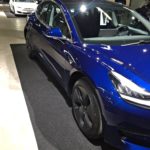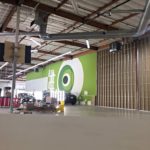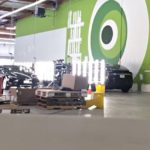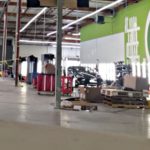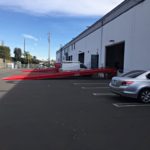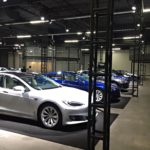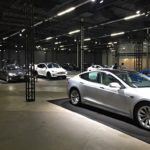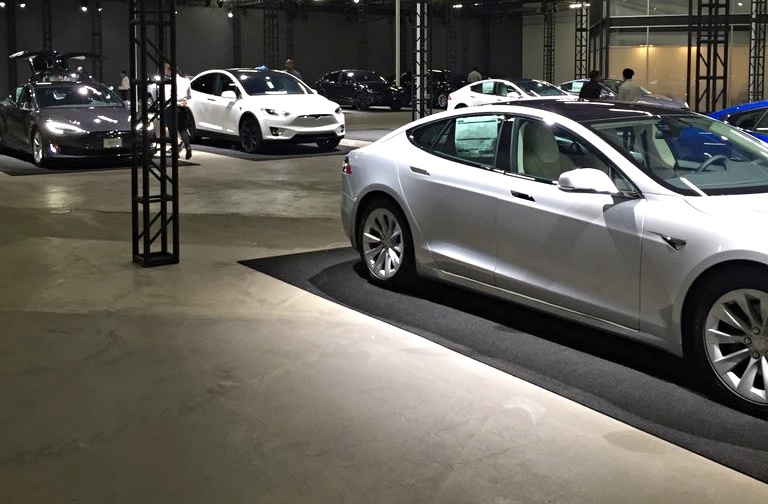
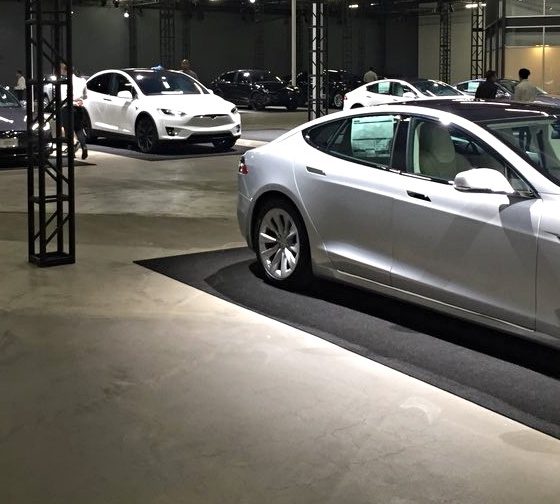
News
Inside Tesla’s Marina Del Rey facility where Model 3 deliveries are taking place
As Tesla continues to ramp up its Model 3 production, the carmaker recently opened the doors of its latest customer delivery center in the town of Marina Del Rey in Los Angeles, CA. Not long after, the facility’s parking lot was spotted with Model S, Model 3 and Model X vehicle inventory, suggesting that customer deliveries were about to take place. Now, a Tesla owner who goes by the Twitter handle @TeslaMS60 has provided a rare look inside the carmaker’s MDR delivery center, revealing some of the most interesting parts of the company’s latest facility.
Teslarati obtained the following images of the delivery area inside the MDR facility, taken on December 22, 2017. Other pictures, particularly those of the quality control (QC) area and the back holding lot, were taken a few days after the facility officially opened for business.
As stated by @TeslaMS60, the interior of the carmaker’s new Marina Del Rey center is similar to other Tesla Service Centers and delivery locations across the country, with a dedicated children’s play area, sofas for waiting customers and a coffee machine that’s made available for customers.
According to TeslaMS60, a QC area occupies roughly half of the ground floor where customer deliveries are also taking place. A series of lightboxes are used to inspect the paint and finish of each car that makes its way to the facility from the company’s Fremont, California factory.
The dedicated quality control area is likely in direct response to complaints made earlier this year by some Tesla owners who expressed their disappointment over the substandard finish of some Model S and Model X units they received, some of which were painted and detailed haphazardly.
While the lightboxes in the QC area were not accessible to customers, @TeslaMS60 did notice that it was adjacent to the loading docks where the Model S, Model X and Model 3 units are unloaded from transport trailers. After rolling through a quality check, the vehicles are moved to the front of the building where they meet their respective owners.
As it appears now, the interior space of the Marina Del Rey facility could accommodate about 100 simultaneous deliveries. The space outside the building seems to be designed to hold around 200-300 cars as well.
From what could be determined in the pictures provided by @TeslaMS60, it seems like Tesla’s new MDR center is specifically designed for quick and efficient deliveries. If any, its dedicated QC area also confirms that Tesla is attempting to avoid future service visits due to quality issues on its vehicles as much as possible.
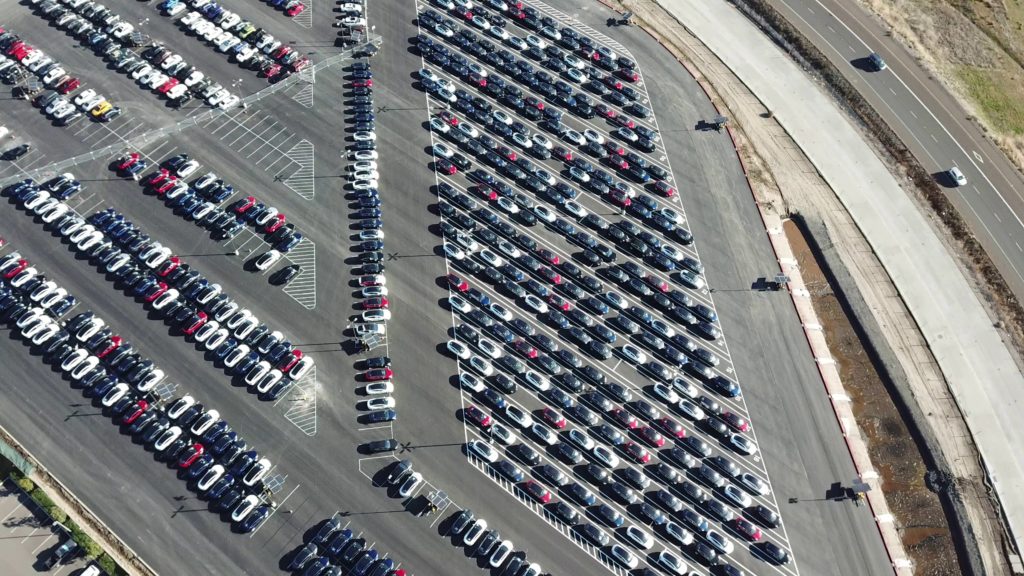
Tesla Model 3 inventory at the Fremont factory spotted by drone
With the Model 3 ramp-up seemingly underway, keeping the production line and the delivery facilities moving without a hitch is incredibly pertinent. In this respect, Tesla’s latest Los Angeles delivery center seems to be ready to take on the job.
Tesla is currently focusing on the ramp-up of the Model 3, its first mass-market compact sedan. Despite facing battery production challenges in the early manufacturing process, Tesla is expecting to hit a production rate of 5,000 Model 3 units per week by the end of Q1 2018.

News
Tesla FSD fleet is nearing 7 billion total miles, including 2.5 billion city miles
As can be seen on Tesla’s official FSD webpage, vehicles equipped with the system have now navigated over 6.99 billion miles.

Tesla’s Full Self-Driving (Supervised) fleet is closing in on almost 7 billion total miles driven, as per data posted by the company on its official FSD webpage.
These figures hint at the massive scale of data fueling Tesla’s rapid FSD improvements, which have been quite notable as of late.
FSD mileage milestones
As can be seen on Tesla’s official FSD webpage, vehicles equipped with the system have now navigated over 6.99 billion miles. Tesla owner and avid FSD tester Whole Mars Catalog also shared a screenshot indicating that from the nearly 7 billion miles traveled by the FSD fleet, more than 2.5 billion miles were driven inside cities.
City miles are particularly valuable for complex urban scenarios like unprotected turns, pedestrian interactions, and traffic lights. This is also the difference-maker for FSD, as only complex solutions, such as Waymo’s self-driving taxis, operate similarly on inner-city streets. And even then, incidents such as the San Francisco blackouts have proven challenging for sensor-rich vehicles like Waymos.
Tesla’s data edge
Tesla has a number of advantages in the autonomous vehicle sector, one of which is the size of its fleet and the number of vehicles training FSD on real-world roads. Tesla’s nearly 7 billion FSD miles then allow the company to roll out updates that make its vehicles behave like they are being driven by experienced drivers, even if they are operating on their own.
So notable are Tesla’s improvements to FSD that NVIDIA Director of Robotics Jim Fan, after experiencing FSD v14, noted that the system is the first AI that passes what he described as a “Physical Turing Test.”
“Despite knowing exactly how robot learning works, I still find it magical watching the steering wheel turn by itself. First it feels surreal, next it becomes routine. Then, like the smartphone, taking it away actively hurts. This is how humanity gets rewired and glued to god-like technologies,” Fan wrote in a post on X.
News
Tesla starts showing how FSD will change lives in Europe
Local officials tested the system on narrow country roads and were impressed by FSD’s smooth, human-like driving, with some calling the service a game-changer for everyday life in areas that are far from urban centers.

Tesla has launched Europe’s first public shuttle service using Full Self-Driving (Supervised) in the rural Eifelkreis Bitburg-Prüm region of Germany, demonstrating how the technology can restore independence and mobility for people who struggle with limited transport options.
Local officials tested the system on narrow country roads and were impressed by FSD’s smooth, human-like driving, with some calling the service a game-changer for everyday life in areas that are far from urban centers.
Officials see real impact on rural residents
Arzfeld Mayor Johannes Kuhl and District Administrator Andreas Kruppert personally tested the Tesla shuttle service. This allowed them to see just how well FSD navigated winding lanes and rural roads confidently. Kruppert said, “Autonomous driving sounds like science fiction to many, but we simply see here that it works totally well in rural regions too.” Kuhl, for his part, also noted that FSD “feels like a very experienced driver.”
The pilot complements the area’s “Citizen Bus” program, which provides on-demand rides for elderly residents who can no longer drive themselves. Tesla Europe shared a video of a demonstration of the service, highlighting how FSD gives people their freedom back, even in places where public transport is not as prevalent.
What the Ministry for Economic Affairs and Transport says
Rhineland-Palatinate’s Minister Daniela Schmitt supported the project, praising the collaboration that made this “first of its kind in Europe” possible. As per the ministry, the rural rollout for the service shows FSD’s potential beyond major cities, and it delivers tangible benefits like grocery runs, doctor visits, and social connections for isolated residents.
“Reliable and flexible mobility is especially vital in rural areas. With the launch of a shuttle service using self-driving vehicles (FSD supervised) by Tesla in the Eifelkreis Bitburg-Prüm, an innovative pilot project is now getting underway that complements local community bus services. It is the first project of its kind in Europe.
“The result is a real gain for rural mobility: greater accessibility, more flexibility and tangible benefits for everyday life. A strong signal for innovation, cooperation and future-oriented mobility beyond urban centers,” the ministry wrote in a LinkedIn post.
News
Tesla China quietly posts Robotaxi-related job listing
Tesla China is currently seeking a Low Voltage Electrical Engineer to work on circuit board design for the company’s autonomous vehicles.

Tesla has posted a new job listing in Shanghai explicitly tied to its Robotaxi program, fueling speculation that the company is preparing to launch its dedicated autonomous ride-hailing service in China.
As noted in the listing, Tesla China is currently seeking a Low Voltage Electrical Engineer to work on circuit board design for the company’s autonomous vehicles.
Robotaxi-specific role
The listing, which was shared on social media platform X by industry watcher @tslaming, suggested that Tesla China is looking to fill the role urgently. The job listing itself specifically mentions that the person hired for the role will be working on the Low Voltage Hardware team, which would design the circuit boards that would serve as the nervous system of the Robotaxi.
Key tasks for the role, as indicated in the job listing, include collaboration with PCB layout, firmware, mechanical, program management, and validation teams, among other responsibilities. The role is based in Shanghai.
China Robotaxi launch
China represents a massive potential market for robotaxis, with its dense urban centers and supportive policies in select cities. Tesla has limited permission to roll out FSD in the country, though despite this, its vehicles have been hailed as among the best in the market when it comes to autonomous features. So far, at least, it appears that China supports Tesla’s FSD and Robotaxi rollout.
This was hinted at in November, when Tesla brought the Cybercab to the 8th China International Import Expo (CIIE) in Shanghai, marking the first time that the autonomous two-seater was brought to the Asia-Pacific region. The vehicle, despite not having a release date in China, received a significant amount of interest among the event’s attendees.
